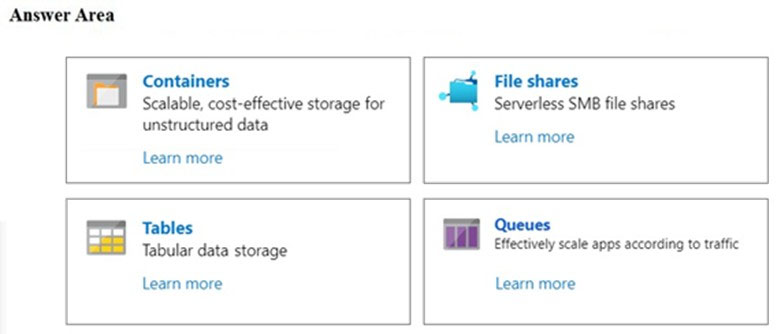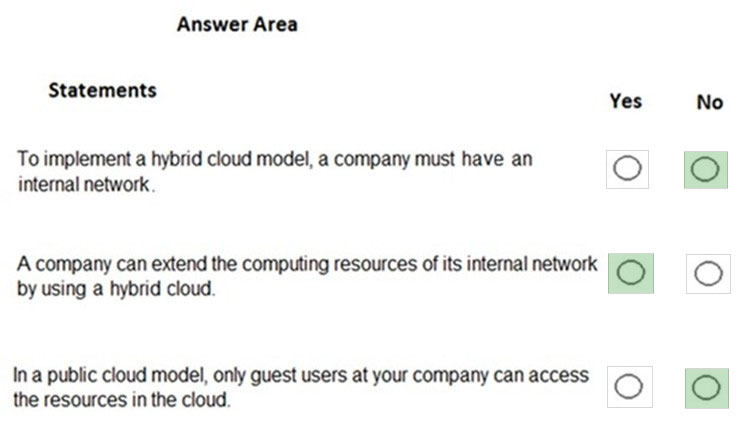AZ-900: Microsoft Azure Fundamentals
You plan to create an Azure virtual machine.
You need to identify which storage service must be used to store the unmanaged data disks of the virtual machine.
What should you identify?

Containers
File shares
Tables
Queues
Answer is Containers
Azure containers are the backbone of the virtual disks platform for Azure IaaS. Both Azure OS and data disks are implemented as virtual disks where data is durably persisted in the Azure Storage platform and then delivered to the virtual machines for maximum performance. Azure Disks are persisted in Hyper-V VHD format and stored as a page blob in Azure Storage.
Reference:
https://docs.microsoft.com/en-us/azure/storage/blobs/storage-blob-pageblob-overview
Match the Azure services benefits to the correct descriptions.

Answer is Fault Tolerance, Disaster Recovery, Dynamic Scalability and Low Latency
Box 1:
Fault tolerance is the ability of a service to remain available after a failure of one of the components of the service. For example, a service running on multiple servers can withstand the failure of one of the servers.
Box 2:
Disaster recovery is the recovery of a service after a failure. For example, restoring a virtual machine from backup after a virtual machine failure.
Box 3:
Dynamic scalability is the ability for compute resources to be added to a service when the service is under heavy load. For example, in a virtual machine scale set, additional instances of the virtual machine are added when the existing virtual machines are under heavy load.
Box 4:
Latency is the time a service to respond to requests. For example, the time it takes for a web page to be returned from a web server. Low latency means low response time which means a quicker response.
References:
https://msdn.microsoft.com/en-us/magazine/mt422582.aspx
https://searchdisasterrecovery.techtarget.com/definition/cloud-disaster-recovery-cloud-DR
http://www.siasmsp.com/the-benefit-of-scalability-in-cloud-computing-2/
https://azure.microsoft.com/en-in/overview/what-is-cloud-computing/
Your company plans to migrate all its data and resources to Azure.
The company's migration plan states that only Platform as a Service (PaaS) solutions must be used in Azure.
You need to deploy an Azure environment that meets the company's migration plan.
What should you create?
Azure virtual machines, Azure SQL databases, and Azure Storage accounts.
an Azure App Service and Azure virtual machines that have Microsoft SQL Server installed.
an Azure App Service and Azure SQL databases.
Azure storage accounts and web server in Azure virtual machines.
Answer is an Azure App Service and Azure SQL databases.
Azure App Service and Azure SQL databases are examples of Azure PaaS solutions. Therefore, this solution does meet the goal.
A company has the following on-premise data stores.
- A Microsoft SQL Server 2012 database.
- A Microsoft SQL Server 2008 database.
- The data needs to be migrated to Azure.
Requirement 2 - The data in a table in the Microsoft SQL Server 2008 database needs to be migrated to an Azure CosmosDB account that uses the SQL API.
Which of the following should be used to accomplish Requirement2?
AzCopy
Azure CosmosDB Data Migration tool
Data Management Gateway
Data Migration Assistant
Answer is Azure CosmosDB Data Migration tool
Reference: https://docs.microsoft.com/en-us/azure/cosmos-db/import-data
You have an on-premises network that contains several servers.
You plan to migrate all the servers to Azure.
You need to recommend a solution to ensure that some of the servers are available if a single Azure data center goes offline for an extended period.
What should you include in the recommendation?
fault tolerance
elasticity
scalability
low latency
Answer is fault tolerance
Fault tolerance is the ability of a system to continue to function in the event of a failure of some of its components.
In this question, you could have servers that are replicated across datacenters.
Availability zones expand the level of control you have to maintain the availability of the applications and data on your VMs. Availability Zones are unique physical locations within an Azure region. Each zone is made up of one or more datacenters equipped with independent power, cooling, and networking. To ensure resiliency, there are a minimum of three separate zones in all enabled regions. The physical separation of Availability Zones within a region protects applications and data from datacenter failures.
With Availability Zones, Azure offers industry best 99.99% VM uptime SLA. By architecting your solutions to use replicated VMs in zones, you can protect your applications and data from the loss of a datacenter. If one zone is compromised, then replicated apps and data are instantly available in another zone.
References:
https://docs.microsoft.com/en-us/azure/virtual-machines/windows/manage-availability
To complete the sentence, select the appropriate option in the answer area.

Answer is in the public cloud
A private cloud is hosted in your datacenter. Therefore, you cannot close your datacenter if you are using a private cloud.
A public cloud is hosted externally, for example, in Microsoft Azure. An organization that hosts its infrastructure in a public cloud can close its data center.
Public cloud is the most common deployment model. In this case, you have no local hardware to manage or keep up-to-date" everything runs on your cloud provider's hardware.
Microsoft Azure is an example of a public cloud provider.
In a private cloud, you create a cloud environment in your own datacenter and provide self-service access to compute resources to users in your organization.
This offers a simulation of a public cloud to your users, but you remain completely responsible for the purchase and maintenance of the hardware and software services you provide.
Reference:
https://docs.microsoft.com/en-gb/learn/modules/principles-cloud-computing/4-cloud-deployment-models
Your company hosts an accounting application named App1 that is used by all the customers of the company. App1 has low usage during the first three weeks of each month and very high usage during the last week of each month. Which benefit of Azure Cloud Services supports cost management for this type of usage pattern?
high availability
high latency
elasticity
load balancing
Answer is elasticity
Elasticity in this case is the ability to provide additional compute resource when needed and reduce the compute resource when not needed to reduce costs. Autoscaling is an example of elasticity. Elastic computing is the ability to quickly expand or decrease computer processing, memory and storage resources to meet changing demands without worrying about capacity planning and engineering for peak usage. Typically controlled by system monitoring tools, elastic computing matches the amount of resources allocated to the amount of resources actually needed without disrupting operations. With cloud elasticity, a company avoids paying for unused capacity or idle resources and doesnג€™t have to worry about investing in the purchase or maintenance of additional resources and equipment. References: https://azure.microsoft.com/en-gb/overview/what-is-elastic-computing/
To complete the sentence, select the appropriate option in the answer area.

fault tolerance
disaster recovery
elasticity
high availability
Answer is disaster recovery
Reference:
https://docs.microsoft.com/en-us/azure/site-recovery/site-recovery-overview
For each of the following statements, select Yes if the statement is true. Otherwise, select No.


Box 1: No
It is not true that a company must always migrate from an internal network to implement a hybrid cloud. You could start with a public cloud and then combine that with an on-premise infrastructure to implement a hybrid cloud.
Box 2: Yes
A company can extend the computing resources of its internal network by using the public cloud. This is very common. When you need more resources, rather than pay out for new on-premises infrastructure, you can configure a cloud environment and connect your on-premises network to the cloud environment by using a VPN.
Box 3: No
It is not true that only guest users can access cloud resources. You can give anyone with an account in Azure Active Directory access to the cloud resources.
There are many authentication scenarios but a common one is to replicate your on-premises Active Directory accounts to Azure Active Directory and provide access to the Azure Active Directory accounts. Another commonly used authentication method is Federation where authentication for access to cloud resources is passed to another authentication provider such as an on-premises Active Directory.
Reference:
https://azure.microsoft.com/en-gb/overview/what-is-hybrid-cloud-computing/
To which cloud models can you deploy physical servers?
private cloud and hybrid cloud only
private cloud only
private cloud, hybrid cloud and public cloud
hybrid cloud only
Answer is private cloud and hybrid cloud only
A private cloud is on-premises so you can deploy physical servers.
A hybrid cloud is a mix of on-premise and public cloud resources. You can deploy physical servers on-premises.
Reference:
https://azure.microsoft.com/en-gb/overview/what-is-hybrid-cloud-computing/